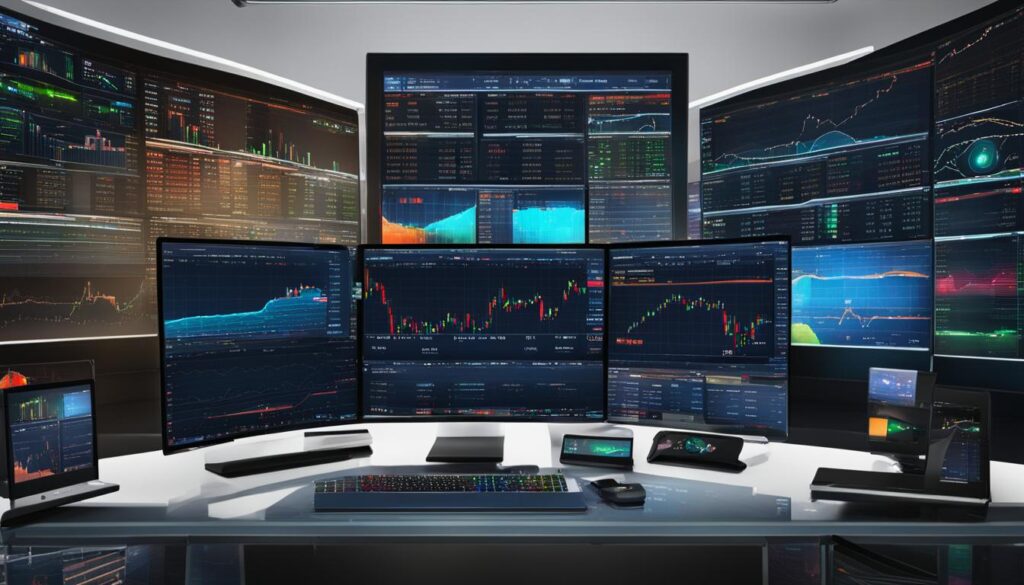As a futures trader, I understand the importance of having the right tools to navigate the complex world of financial markets. Technical analysis tools are essential for analyzing market trends, identifying patterns, and making informed trading decisions. These tools provide valuable insights into price movements, volume trends, and market sentiment, helping traders stay ahead of the game.
In this section, we will explore the key technical analysis tools that every futures trader should have in their arsenal. By understanding and utilizing these tools effectively, traders can enhance their trading strategies and increase their chances of success.
Key Takeaways:
- Technical analysis tools are crucial for futures traders to analyze and predict market movements.
- Indicators, chart patterns, and other tools help traders make informed decisions and enhance their trading strategies.
- Seven indicators that are indispensable for day trading include OBV, A/D line, average directional index, Aroon oscillator, MACD, RSI, and stochastic oscillator.
- There are various overlays and oscillators that technical analysts use to analyze price charts and generate trading signals.
- Brokers such as Ally Invest, Charles Schwab, and E*TRADE offer platforms with robust charting capabilities and technical analysis tools.
Seven Indispensable Indicators for Day Trading
When it comes to day trading, technical indicators are powerful tools that help traders make informed decisions in the fast-paced market environment. These indicators analyze historical price data and provide valuable insights into market trends, volume movements, and trend strength. By incorporating these indicators into their trading strategies, day traders can effectively identify opportunities and execute timely buy and sell orders.
1. On-Balance Volume (OBV)
The On-Balance Volume (OBV) indicator tracks the cumulative volume of an asset over a given period. It measures the flow of volume relative to price movements and helps traders identify if buying or selling pressure is accumulating. Traders often refer to OBV to confirm price movements and gauge the strength of a trend.
2. Accumulation/Distribution (A/D) Line
The Accumulation/Distribution (A/D) Line is another popular indicator that combines volume and price data. It calculates the buying and selling pressure by taking into account the relationship between the closing price and the trading range. Traders use the A/D Line to identify the overall trend, divergences, and potential buying or selling opportunities.
3. Average Directional Index (ADX)
The Average Directional Index (ADX) measures the strength of a trend rather than its direction. It consists of two lines, the Positive Directional Indicator (+DI) and the Negative Directional Indicator (-DI). Traders often refer to the ADX to determine if a trend is strong enough to consider taking a trade.
4. Aroon Oscillator
The Aroon Oscillator identifies how long it has been since a high or low occurred in the price of an asset and quantifies the strength of the trend. It consists of two components, the Aroon-Up and Aroon-Down, which oscillate between 0 and 100. Traders use the Aroon Oscillator to identify trend reversals and potential entry or exit points.
5. Moving Average Convergence Divergence (MACD)
The Moving Average Convergence Divergence (MACD) is a versatile indicator that combines trend-following and momentum elements. It consists of two lines, the MACD line and the signal line, as well as a histogram displaying the difference between the two. Traders often use the MACD to identify potential trend reversals, overbought or oversold conditions, and generate buy or sell signals.
6. Relative Strength Index (RSI)
The Relative Strength Index (RSI) is a momentum oscillator that measures the speed and change of price movements. It oscillates between 0 and 100 and is plotted on a separate scale beneath the price chart. Traders use the RSI to identify overbought or oversold conditions, trend reversals, and potential entry or exit points.
7. Stochastic Oscillator
The Stochastic Oscillator compares the closing price of an asset to its price range over a specific period. It consists of two lines, %K and %D, which oscillate between 0 and 100. Traders often use the Stochastic Oscillator to identify overbought or oversold conditions, potential trend reversals, and generate buy or sell signals.
These seven indicators are considered indispensable by day traders due to their ability to provide crucial insights into market dynamics. By combining multiple indicators and analyzing their signals in conjunction with other market factors, day traders can develop robust trading strategies and improve their chances of success.
Tools of the Trade for Technical Analysis
As a technical analyst, I rely on a wide range of tools to analyze price charts, identify patterns and trends, and generate trading signals. These tools fall into two main categories: overlays and oscillators. Overlays are plotted on top of price charts, providing visual representation and insights into price movements. Oscillators, on the other hand, are plotted below or above price charts, indicating overbought or oversold conditions.
One of the most frequently used overlay tools in technical analysis is the moving average. It helps smooth out price fluctuations and provides a clearer picture of the overall trend. Another popular overlay tool is Bollinger Bands®, which consists of a central moving average line and two bands that represent volatility levels.
When it comes to oscillators, the stochastic oscillator is often a go-to tool for many technical analysts. It compares the closing price of a security to its price range over a specific period, highlighting potential reversal points. The moving average convergence divergence (MACD) is another widely used oscillator. It measures the convergence and divergence of two moving averages, signaling trend changes and potential trading opportunities.
Technical analysis is all about reading price charts and using various tools to gain insights into market behavior. By combining overlays and oscillators, I can assess both price movements and momentum, helping me make more informed trading decisions.
Example of Overlays and Oscillators
| Overlay Tools | Oscillator Tools |
|---|---|
| Moving Average | Stochastic Oscillator |
| Bollinger Bands® | Moving Average Convergence Divergence (MACD) |
By combining these tools and analyzing securities from different angles, I can uncover valuable trade ideas and potential market opportunities. Technical analysis tools empower me to make data-driven, objective decisions, leading to more consistent and successful trading strategies.
Brokers Offering Technical Analysis Tools
When it comes to futures trading, having access to reliable technical analysis tools is essential. Fortunately, many brokers understand the importance of these tools and offer robust platforms that cater to traders’ needs. Let’s take a look at some of the top brokers that provide comprehensive technical analysis capabilities.
Ally Invest
Ally Invest is a popular brokerage platform that offers a range of technical analysis tools. Their platform features advanced charting capabilities, customizable indicators, and real-time data. Traders can analyze stock charts, identify trends, and make informed trading decisions to maximize their profits.
Charles Schwab
Charles Schwab is known for its comprehensive suite of trading tools, including a wide range of technical analysis resources. Traders can access customizable charts, advanced indicators, and real-time market data. The platform also offers educational resources to help traders enhance their technical analysis skills.
E*TRADE
E*TRADE’s platform offers a wealth of technical analysis tools to support traders in their decision-making process. Traders can utilize customizable charting features, a variety of technical indicators, and real-time streaming data. Additionally, E*TRADE provides educational resources to help traders understand and implement technical analysis strategies effectively.
Fidelity Investments
Fidelity Investments is a reputable broker that provides traders with comprehensive technical analysis tools. Their platform offers advanced charting capabilities, a variety of technical indicators, and real-time market data. Traders can analyze charts, identify patterns, and make informed trading decisions based on technical analysis insights.
Interactive Brokers
Interactive Brokers is known for its advanced trading platform that caters to active traders. The platform offers a wide range of technical analysis tools, including customizable charts, advanced indicators, and real-time data. Traders can take advantage of these tools to analyze securities and execute trades efficiently.
Lightspeed
Lightspeed is a broker that specializes in catering to professional traders, including those who heavily rely on technical analysis. Their platform offers advanced charting capabilities, a variety of technical indicators, and real-time data. Traders can customize their charts and indicators to suit their trading strategies.
TD Ameritrade
TD Ameritrade provides traders with a robust platform that includes a range of technical analysis tools. Traders can access customizable charts, multiple technical indicators, and real-time market data. Additionally, TD Ameritrade offers educational resources to help traders enhance their technical analysis skills.
“I have found that utilizing the technical analysis tools provided by these brokers has greatly enhanced my trading strategies and decision-making process. Having access to customizable charts, a variety of indicators, and real-time data has allowed me to identify trends and make more informed trading decisions.”
If you are a futures trader looking to enhance your technical analysis capabilities, consider utilizing the platforms offered by these brokers. Their comprehensive tools and resources can help you analyze stocks, identify opportunities, and develop successful trading strategies. Remember to choose the tools that align with your trading style and continuously expand your technical analysis skills for long-term success.
| Broker | Charting Capabilities | Customizable Indicators | Real-time Data |
|---|---|---|---|
| Ally Invest | ✔️ | ✔️ | ✔️ |
| Charles Schwab | ✔️ | ✔️ | ✔️ |
| E*TRADE | ✔️ | ✔️ | ✔️ |
| Fidelity Investments | ✔️ | ✔️ | ✔️ |
| Interactive Brokers | ✔️ | ✔️ | ✔️ |
| Lightspeed | ✔️ | ✔️ | ✔️ |
| TD Ameritrade | ✔️ | ✔️ | ✔️ |
Conclusion
Technical analysis is an essential aspect of futures trading, providing valuable insights into market trends, patterns, and potential trading opportunities. By leveraging the right tools, such as indicators and charting capabilities, futures traders can enhance their understanding of the market and make well-informed trading decisions. The availability of analysis platforms provided by brokers further empowers traders to refine their strategies and stay ahead in the dynamic world of trading.
To excel in technical analysis, it is crucial for traders to continuously develop their skills and stay updated on the latest trends and techniques. By consistently honing their abilities, traders can better identify patterns, analyze market behavior, and adapt their trading strategies accordingly. Additionally, traders should select tools that align with their trading style and objectives, as different tools offer unique insights and functionalities.
With the expanding range of technical analysis tools available, futures traders can gain a competitive edge in the market. By combining their expertise with these tools, traders can improve their accuracy in predicting market movements, optimizing their chances of success. Remember, trading strategies based on technical analysis should always be supplemented with fundamental research and risk management practices for a well-rounded approach to trading.
FAQ
What role do technical analysis tools play in futures trading?
Technical analysis tools help futures traders analyze and predict market movements, enhancing their trading strategies and decision-making process.
What are some of the top indicators used by day traders?
Some of the top indicators used by day traders include on-balance volume (OBV), accumulation/distribution (A/D) line, average directional index, Aroon oscillator, moving average convergence divergence (MACD), relative strength index (RSI), and stochastic oscillator.
How do technical analysts utilize tools for analyzing price charts?
Technical analysts use tools such as overlays (e.g., moving averages and Bollinger Bands®) and oscillators (e.g., stochastic oscillator and MACD) to analyze price charts, identify patterns and trends, and generate trading signals.
Do brokers provide technical analysis tools to their clients?
Yes, many brokers provide their clients with built-in technical analysis tools, offering robust charting capabilities, customizable indicators, and real-time data. Examples include Ally Invest, Charles Schwab, E*TRADE, Fidelity Investments, Interactive Brokers, Lightspeed, and TD Ameritrade.
Why is technical analysis important for futures trading?
Technical analysis is a vital aspect of futures trading as it allows traders to analyze market trends, identify patterns, and make informed trading decisions. By utilizing the right tools, futures traders can enhance their market predictions and refine their trading strategies for success.
Source Links
- https://www.investopedia.com/articles/active-trading/121014/best-technical-analysis-trading-software.asp
- https://www.investopedia.com/top-7-technical-analysis-tools-4773275
- https://ninjatrader.com/futures/blogs/technical-analysis-for-futures-trading-made-easy/
Disclaimer
All information on this website is of a general nature. The information is not adapted to conditions that are specific to your person or entity. The information provided can not be considered as personal, professional or legal advice or investment advice to the user.
This website and all information is intended for educational purposes only and does not give financial advice. Signal Mastermind Signals is not a service to provide legal and financial advice; any information provided here is only the personal opinion of the author (not advice or financial advice in any sense, and in the sense of any act, ordinance or law of any country) and must not be used for financial activities. Signal Mastermind Signals does not offer, operate or provide financial, brokerage, commercial or investment services and is not a financial advisor. Rather, Signal Mastermind Signals is an educational site and a platform for exchanging Forex information. Whenever information is disclosed, whether express or implied, about profit or revenue, it is not a guarantee. No method or trading system ensures that it will generate a profit, so always remember that trade can lead to a loss. Trading responsibility, whether resulting in profits or losses, is yours and you must agree not to hold Signal Mastermind Signals or other information providers that are responsible in any way whatsoever. The use of the system means that the user accepts Disclaimer and Terms of Use.
Signal Mastermind Signals is not represented as a registered investment consultant or brokerage dealer nor offers to buy or sell any of the financial instruments mentioned in the service offered.
While Signal Mastermind Signals believes that the content provided is accurate, there are no explicit or implied warranties of accuracy. The information provided is believed to be reliable; Signal Mastermind Signals does not guarantee the accuracy or completeness of the information provided. Third parties refer to Signal Mastermind Signals to provide technology and information if a third party fails, and then there is a risk that the information may be delayed or not delivered at all.
All information and comments contained on this website, including but not limited to, opinions, analyzes, news, prices, research, and general, do not constitute investment advice or an invitation to buy or sell any type of instrument. Signal Mastermind Signals assumes no responsibility for any loss or damage that may result, directly or indirectly, from the use or dependence on such information.
All information contained on this web site is a personal opinion or belief of the author. None of these data is a recommendation or financial advice in any sense, also within the meaning of any commercial act or law. Writers, publishers and affiliates of Signal Mastermind Signals are not responsible for your trading in any way.
The information and opinions contained in the site are provided for information only and for educational reasons, should never be considered as direct or indirect advice to open a trading account and / or invest money in Forex trading with any Forex company . Signal Mastermind Signals assumes no responsibility for any decisions taken by the user to create a merchant account with any of the brokers listed on this website. Anyone who decides to set up a trading account or use the services, free of charge or paid, to any of the Broker companies mentioned on this website, bears full responsibility for their actions.
Any institution that offers a service and is listed on this website, including forex brokers, financial companies and other institutions, is present only for informational purposes. All ratings, ratings, banners, reviews, or other information found for any of the above-mentioned institutions are provided in a strictly objective manner and according to the best possible reflection of the materials on the official website of the company.
Forex/CFD trading is potentially high risk and may not be suitable for all investors. The high level of leverage can work both for and against traders. Before each Forex/CFD investment, you should carefully consider your goals, past experience and risk level. The opinions and data contained on this site should not be considered as suggestions or advice for the sale or purchase of currency or other instruments. Past results do not show or guarantee future results.
Neither Signal Mastermind Signals nor its affiliates ensure the accuracy of the content provided on this Site. You explicitly agree that viewing, visiting or using this website is at your own risk.




